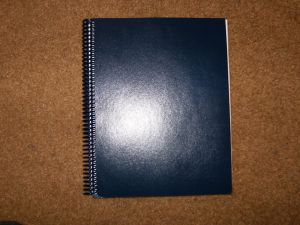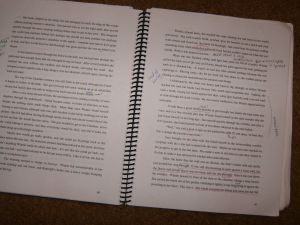Each author’s editing process is as individual as their writing process is. Here’s mine.
Step 1. Write a book. (This takes anywhere from two to ten months depending on genre, how much I actually know about what I’m making up, and whether or not my day job is trying to kill me.)
Step 2. Secure readers. (I know some people don’t like people to read their first drafts, but I don’t like to edit without knowing if I’m missing major plot issues that I am blind to.)
Step 3. Create Master Copy. (see picture) I hate editing on the computer. I hate reading on the computer, for that matter. So I always print out the draft and bind it. This costs somewhere between $15 to $30 depending on length of book, what you’re using for the cover (I prefer vinyl over card paper), and what kind of binding you get. (For the love of all that is Holy, do the coil. It’s more expensive but it’s so worth it.)
Step 4. Put all reader comments INTO the Master Copy. Hence the name Master Copy. I try to color code my readers. If they’re responding to specific lines, I’ll put their comment right next to it. Plot comments get put where I’ll remember to do something about it.
Step 5. Read and free-edit on Master Copy. Basically this entails me reading the story and leaving comments as they occur to me. It’s more of a readthrough than a true edit.
Step 6. If any major rewrites are needed, I’ll do them at this point.
Step 7. Print out another copy of the story. (The poor trees.)
Step 8. I go through, chapter by chapter, and edit. Editing at this point includes a readthrough with comments, then the cutting/rearranging/rewriting portion. Then I reference the Master Copy to make sure I haven’t missed anything major that myself or one of my readers has noted. I then do a polish on the chapter, make any notes of things that affect other chapters (usually in the chapters in question in the Master Copy), and move on to the next.
Step 9. After I finish the entire book, I do another readthrough and fix anything (hopefully minor things) that I missed during my in-depth edit.
Step 10. Find readers (hopefully a mix of people who read the first draft and people who did not).
Step 11. Repeat steps 8-10.
At this point I start the submission process, but that’s a topic for later posts.
What’s your process?






This is brilliant! I love the bound copy, I’ve never heard of someone doing that. I’ll remember this when I’ve finished my first draft.
Having a master copy is great. I read somewhere that you can go through Lulu and get a personal copy for less than 10 dollars? But I haven’t followed through to check that out. Great post!
That’s probably true – I have a novella on Lulu that’s base cost is about $8 – but I prefer the Master Copy because it gives you more room to leave notes. (Also, the thought of writing on a real book – even if it’s just a draft copy of one of my own – feels dirty to me.)
I like the Holly Lisle method, where I print it out and dive in, no read-through. It is very AAAHHH! inducing, but it works for me.
How do you fix overarcing plot issues? I mean, it just seems to me that I need the readthrough so I have an idea of the whole plot so I can add in (or remove) things as I go along in my indepth edit.
My intended process for edition: (I’ve edited “on the go” before, never with a completely finished MS – until now!)
1. On-screen edit: The purpose of this is to pick up fat fingered msitakes and obvious nonsense. This will include small additional writing spurts to tighen up certain scenes and large scale deletion.
2. I save this as a different version of the MS (everyone hordes different versions of their MS don’t they?)
3. Print double-line spaced copy with nice margins, bind. Scribble on the back of pages for longer additons.
4. Do major rewrite and tidy.
5. Print and bind a couple more copies and give them to others to read.
6. (optional) Fall out with friends over criticism.
7. Digest criticism. Produce “nearly final version”. Stick in draw and forget about it for a bit.
Do you go back to it after it’s been in the drawer for awhile?